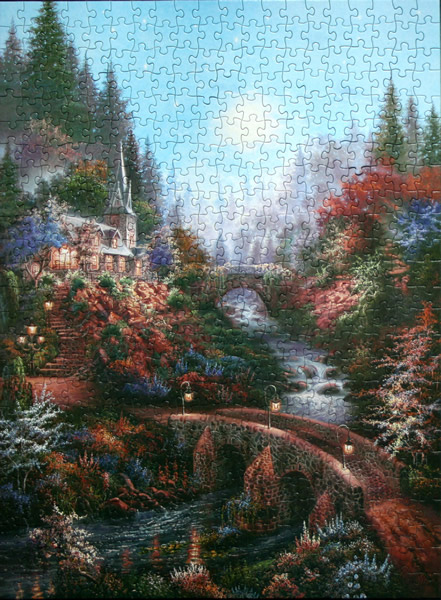
Size: 500 pieces
Dimensions: 48.26 cm x 35.56 cm
Producer: The Canadian Group, Sure-Lox, Keepsakes series, Reusable gift box with magnetic closure, #442220-2
Artist: Klaus Strubel
Painting: photo
Notes: grace, –noun
1. elegance or beauty of form, manner, motion, or action.
2. a pleasing or attractive quality or endowment.
3. favor or good will. [Dictionary.com]
Tag: architecture
Puzzle: Paradise
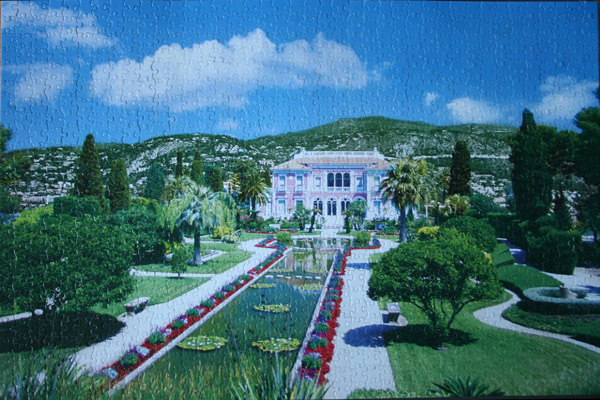
Size: 1000 pieces
Dimensions: 73cm x 48.6cm
Producer: The Canadian Group, Sure-Lox
Notes: The Paradise garden is a form of garden, originally just paradise, a word derived from the Median language, or Old Persian. Its original meaning was “a walled-in compound or garden”.
The paradise garden takes some of its character from its original arid or semi-arid homeland. The most basic feature is the enclosure of the cultivated area. This excludes the wildness of nature, and includes the tended, watered greenery of the garden. The commonest and easiest layout for the perimeter walls is that of a rectangle, and this forms one of the prime features of this kind of garden. Another common theme is the elaborate use of water, often in canals, ponds or rills, sometimes in fountains, less often in waterfalls of various kinds.
The rectangular or rectilinear theme of the garden is often extended to the water features, which may be used to quarter the garden. This layout is echoed in the four rivers of the Garden of Eden, and much of the use and symbolism of the paradise garden is derived from this connection. The contrast between a formal garden layout with the informality of free-growing plants provides a recurring theme to many paradise gardens. [Wiki]
Puzzle: Hearst Castle, San Simeon, CA, U.S.A.
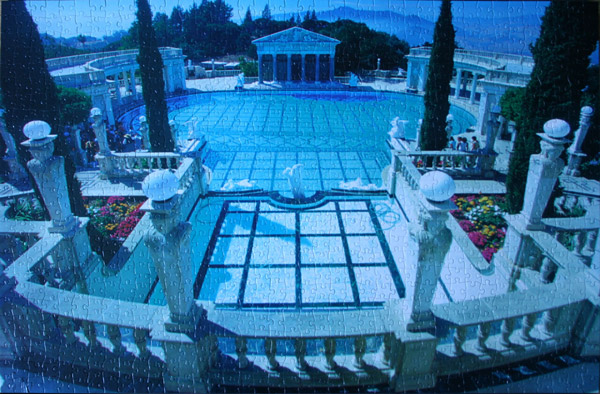
Size: 1000 pieces
Dimensions: 73cm x 48.6cm
Producer: The Canadian Group, Sure-Lox
Notes: Hearst Castle is a National Historic Landmark mansion located on the Central Coast of California, United States. It was designed by architect Julia Morgan between 1919 and 1947 for newspaper magnate William Randolph Hearst, who died in 1951. In 1957, the Hearst Corporation donated the property to the state of California. [Wiki]
Depicted on the puzzle is the Neptune Pool.
Construction for the Neptune Pool spanned 1924-1936. Three swimming pools were built on this site, each successively larger.
Unique aspects of the Neptune Pool include the oil burning heating system, the light-veined Vermont marble decorating the pools and colonnades, and four 17-century Italian bas-reliefs on the sides of the colonnades. [Hearst Castle site]
Puzzle: Tea Rooms
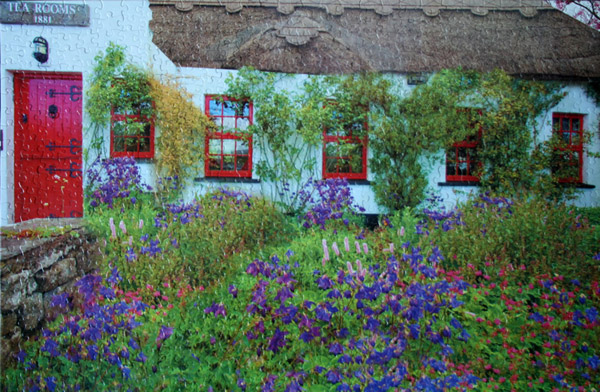
Size: 750 pieces
Dimensions: 59.7 cm x 39.4 cm
Producer: The Canadian Group, Sure-Lox
Notes: A tea house or tearoom is a venue centered on drinking tea. Its function varies widely depending on the culture, and some cultures have a variety of distinct tea-centered houses or parlors that all qualify under the English language term “tea house” or “tea room.”
Tea drinking is a pastime closely associated with the English. Tea first arrived in England during Cromwell’s protectorate and soon became the national drink. Tea drinking became a national pastime for the English. As early as 1784, Rochefoucauld noted that “[t]hroughout the whole of England the drinking of tea is general”. Nevertheless, Anna Russell, Duchess of Bedford, was credited with the invention of afternoon tea in 1840. It spread to other parts of English society by 1864, when the female manager of London’s Aerated Bread Company is attributed with innovating the first commercial public tearoom. [Wiki]
Puzzle: London Street Scene
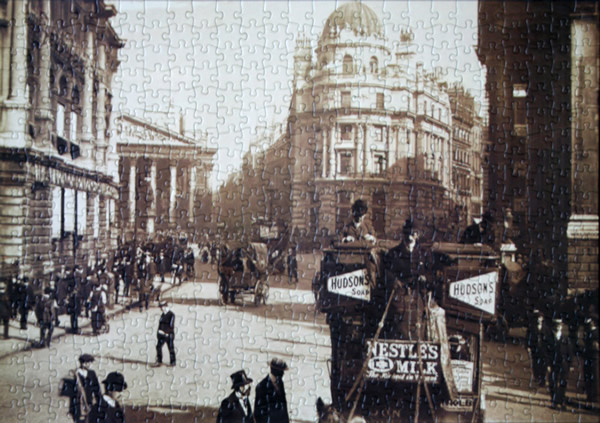
Size: 500 pieces
Dimensions: 35 cm x 48 cm
Producer: Handley Printers Ltd., SK6 1BR, Made in England, jr Deluxe, The Edwardian Collection
Notes: London is the capital city of England and the United Kingdom, the largest metropolitan area in the United Kingdom and the largest urban zone in the European Union by most measures. London has been a major settlement for two millennia, its history going back to its founding by the Romans, who called it Londinium. London’s ancient core, the City of London, largely retains its square-mile medieval boundaries.
London’s buildings are too diverse to be characterised by any particular architectural style, and have been built over a long period of time. Many grand houses and public buildings, such as the National Gallery, are constructed from Portland stone. Some areas of the city, particularly those just west of the centre, are characterised by white stucco or whitewashed buildings. Few structures pre-date the Great Fire of 1666, except for a few trace Roman remains, the Tower of London and a few scattered Tudor survivors in the City. One notable building that remains from the Tudor period is Hampton Court Palace, which is England’s oldest surviving Tudor palace, built by Cardinal Thomas Wolsey circa 1515. Wren’s late 17th century churches and the financial institutions of the 18th and 19th centuries such as the Royal Exchange and the Bank of England, to the early 20th century Old Bailey and the 1960s Barbican Estate form part of the varied architectural heritage. [Wiki]
Puzzle: Dairy Farm, Wisconsin
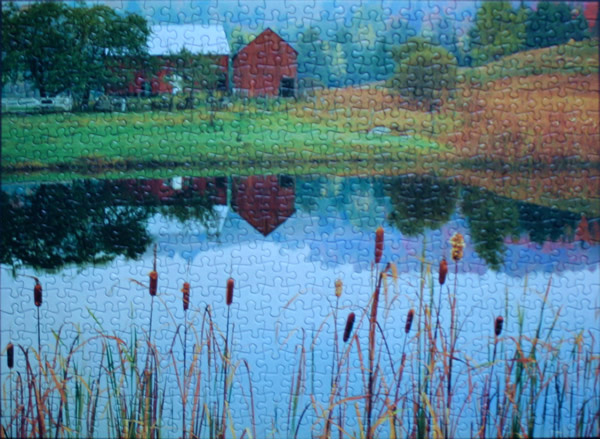
Size: 500 pieces
Dimensions: 48.26 cm x 35.56 cm
Producer: The Canadian Group, Sure-Lox, Images
Artist: Dennis Hallinan
Notes: Dairy farming is a class of agricultural, or an animal husbandry, enterprise, for long-term production of milk, usually from dairy cows but also from goats and sheep, which may be either processed on-site or transported to a dairy factory for processing and eventual retail sale.
Most dairy farms sell the male calves born by their cows, usually for veal production, or breeding depending on quality of the bull calf, rather than raising non-milk-producing stock. Many dairy farms also grow their own feed, typically including corn, alfalfa, and hay. This is fed directly to the cows, or is stored as silage for use during the winter season. [Wiki]
Puzzle: Michelangelo – La Volta Della Cappella Sistina

Size: 1000 pieces
Dimensions: 48 cm x 67.5 cm
Producer: Edizioni Musei Vaticani, Art Collection series
Notes: The Ceiling of the Sistine Chapel, Vatican City: Michelangelo took on the painting of the Sistine Chapel ceiling when he was in his thirties and worked at the task virtually alone with great determination between 1508 and 1512. The nine central panels hold the stories of Genesis from Creation and Original Sin to the rebirth of humankind after the Flood. Five Sibyls and seven Prophets sit in the spaces between the webs, announcing the coming of Christ the Saviour from the depths of the centuries. The webs and lunettes hold the forefathers of Christ, while Michelangelo depicted episodes from the Old Testament in the four corner pendentives referring to the salvific interventions of God in defence of the chosen people. On the 1st November 1512 Julius II inaugurated the “new” Sistine Chapel with the celebration of a High Mass. [Puzzle box]
Puzzle: Paddle Boat Landing by Susan Brabeau
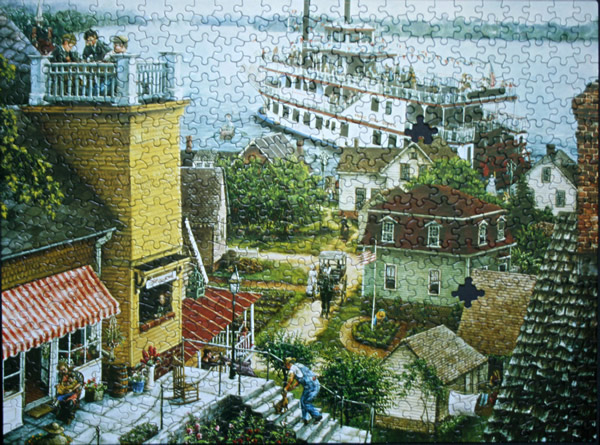
Size: 500 pieces, 2 missing
Dimensions: 45.72cm x 60.96cm
Producer: Collectible Puzzle (?), The Art of Susan Brabeau series
Artist: Susan Brabeau – The imagery of Susan Brabeau appeals to the viewer on several levels: bringing forth moods and sentiments of a by gone era, creating an illusion of life so completely that the viewer can almost hear the sounds within an image.
As with all good story-telling art, the imagery of Susan Brabeau is meant to be felt as well as seen. [The Art of Susan Brabeau]
Notes: A paddle steamer is a steamship or boat, powered by a steam engine, using paddle wheels to propel it through the water. In antiquity, Paddle wheelers followed the development of poles, oars and sails, where the first uses were wheelers driven by animals or humans.
The paddle wheel is a large wheel, built on a steel framework, upon the outer edge of which are fitted numerous paddle blades (called floats or buckets). The bottom quarter or so of the wheel travels underwater. Rotation of the paddle wheel produces thrust, forward or backward as required. More advanced paddle wheel designs have featured feathering methods that keep each paddle blade oriented closer to vertical while it is in the water; this increases efficiency. The upper part of a paddle wheel is normally enclosed in a paddlebox to minimise splashing. [Wiki]
Puzzle: Cher Bourges Cathedral

Size: 500 pieces
Dimensions: 48.26 cm x 35.56 cm
Producer: The Canadian Group, Sure-Lox, Churches and Cathedral series
Notes: Bourges Cathedral (Cathedrale Saint-Etienne de Bourges) is a cathedral, dedicated to Saint Stephen, located in Bourges, France. It is the seat of the Archbishop of Bourges.
It is based on the Notre-Dame in Paris but with significant differences in design. The cathedral is noted for its unique feats of architecture, impressive sculptures and thirteenth-century stained glass windows.
Bourges Cathedral has a highly unique floor plan. It has no transepts, which form the cross-shape of most churches. This lends the cathedral a unique appearance inside and out. On the exterior, thick walls and a myriad of flying buttresses support the unbroken weight of the long nave (122m).
Bourges Cathedral retains almost all its original ambulatory glass (apart from the axial chapel), dating from about 1215. The iconography used in many of these windows uses typology (such as Old Testament episodes prefiguring events in the life of Christ) and symbolism (such as the pelican who pecks her breast to feed her young on her own blood and the lioness who licks the malformed cub into shape) to communicate theological messages. Other windows show the parables of the Good Samaritan and the Prodigal Son, the story of Dives and Lazarus, and the Apocalypse. [Wiki]
Puzzle: Hogwarts Castle, Harry Potter
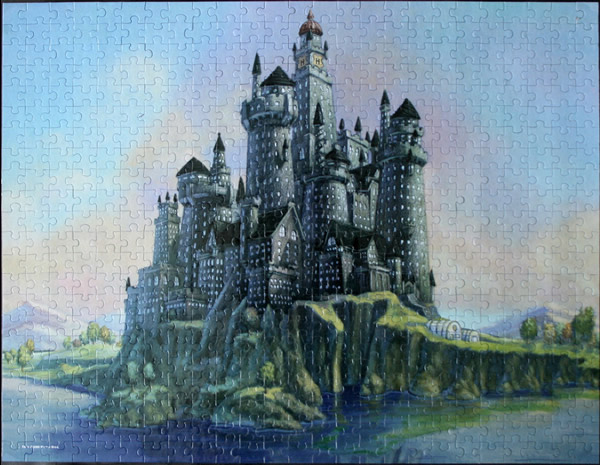
Size: 550 pieces
Producer: Mattel (I believe)
Notes: I do not have a record of the producer of the puzzle as I do not have the box anymore. A clarification is welcome – if you have any clue as to the details regarding this puzzle, I would much appreciate that information.
Hogwarts School of Witchcraft and Wizardry or simply Hogwarts is the primary setting for the first six books of the Harry Potter series by J. K. Rowling, with each book lasting the equivalent of one school year. It is a fictional boarding school of magic for witches and wizards between the ages of eleven and seventeen.
Rowling has suggested that she may have inadvertently taken the name from the hogwort plant (Croton capitatus), which she had seen at Kew Gardens some time before writing the Harry Potter series.
In the novels, Hogwarts is located somewhere in Scotland. The school has numerous charms and spells on and around it that make it impossible for a Muggle (i.e., a non-magical person) to locate it. Such people cannot see the school; rather, they see only ruins and several warnings of danger. The castle has extensive grounds with sloping lawns, flowerbeds and vegetable patches, a loch (called The Black Lake), a large dense forest (called the Forbidden Forest), several greenhouses and other outbuildings, and a full-size Quidditch pitch. There is also an owlery, which houses all the owls owned by the school and those owned by students. It should be noted that some rooms in the school tend to “move around”, and so do the stairs in the grand staircase. [Wiki]
Puzzle: Waits River, Vermont
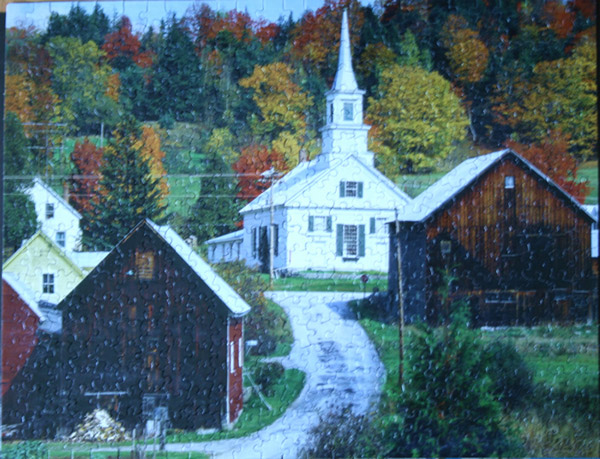
Size: 500 pieces
Notes: I do not have a record of the producer of the puzzle as I do not have the box anymore. A clarification is welcome – if you have any clue as to the details regarding this puzzle, I would much appreciate that information.
The Waits River is a 39.4 km-long river in eastern Vermont in the United States. It is a tributary of the Connecticut River, which flows to Long Island Sound. According to the Geographic Names Information System, it has also been known historically as “Wait’s River” and as “Ma-houn-quam-mas-see.”
The Waits River rises in southwestern Caledonia County in the town of Groton and shortly enters Orange County, where it flows generally southeastwardly through the towns of Orange, Topsham, Corinth and Bradford, to the village of Bradford where it joins the Connecticut River.
In the town of Bradford, it collects a short stream known as the South Branch Waits River, which flows eastwardly from Corinth. [Wiki]
Puzzle: Moritzburg Castle, Saxony, Germany
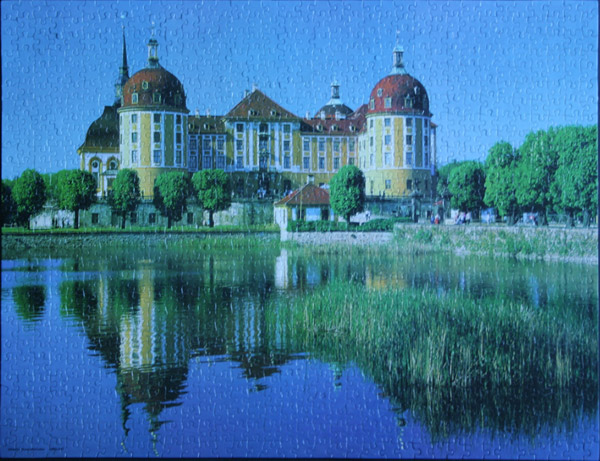
Size: 1000 pieces
Dimensions: 51.12cm x 66.52cm
Producer: Big Ben, MB Puzzles
Notes: The original castle was built from 1542–1546 as a hunting lodge for Moritz of Wettin, then Duke of Saxony. Elector John George II of Saxony had it extended and between 1661 and 1671 the chapel was added after designs by his architect Wolf Caspar von Klengels, a fine example of the early Baroque style. After in 1697 John George’s grandson Elector Frederick Augustus I had converted to Catholicism in order to secure his election as King of Poland, the chapel was consecrated in the Catholic rite. Between 1723 and 1733, Augustus had the castle largely remodelled as a pleasure seat by the architects Matthaus Daniel Poppelmann and Zacharias Longuelune, including a formal park, several ponds and a game preserve. The last resident from the House of Wettin was Prince Ernst Heinrich of Saxony, dispossessed in 1945 by the Soviet Military Administration in Germany. [Wiki]
Puzzle: St. Mark’s Basilica, Italy
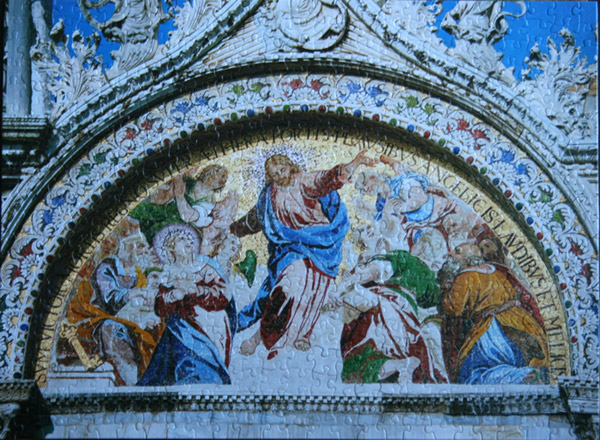
Size: 500 pieces
Dimensions: 48.26 cm x 35.56 cm
Producer: Sure-Lox
Notes: The Patriarchal Cathedral Basilica of Saint Mark is the cathedral church of the Roman Catholic Archdiocese of Venice, northern Italy. It is the most famous of the city’s churches and one of the best known examples of Byzantine architecture. It lies at the eastern end of the Piazza San Marco, adjacent and connected to the Doge’s Palace.
The exterior of the basilica is divided in three registers: lower, upper, and domes. In the lower register of the facade five round-arched portals, enveloped by polychrome marble columns, open into the narthex through bronze-fashioned doors. Above the central door round three bas-relief cycles of Romanesque art. The external cycle frames a 19th century gilded mosaic (Last Judgment) that replaced a damaged one with the same subject (during the centuries many mosaics had to be replaced inside and outside the basilica, but subjects were never changed). Mosaics about St Mark relics’ stories are in the lunettes of the lateral portals; the first on the left is the only one in the facade preserved from the 13th century. In the upper register, from the top of ogee arches, statues of Theological and Cardinal Virtues, four Warrior Saints and St Mark watch over the city. Above the large central window of the facade, under St Mark, the Winged Lion (his symbol) holds the book quoting “Pax Tibi Marce Evangelista Meus” (Peace to you Mark my evangelist). In the lunettes of the lateral ogee arches are four gilded mosaics renewed in the 17th century. In the center of the balcony the Greek Horses face the square. [Wiki]
Puzzle: San Francisco, California
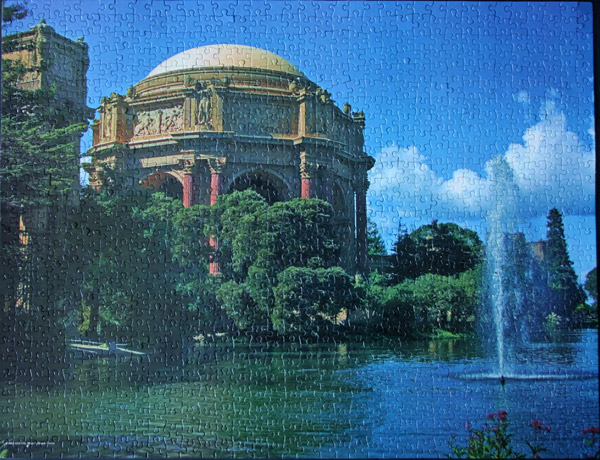
Size: 1000 pieces
Dimensions: 51.12cm x 66.52cm
Producer: Big Ben, MB Puzzles
Notes: The Palace of Fine Arts in the Marina District of San Francisco, California, is a monumental structure originally constructed for the 1915 Panama-Pacific Exposition in order to exhibit works of art presented there. One of only a few surviving structures from the Exposition, it is the only one still situated on its original site. It was rebuilt in 1965, and renovation of the lagoon, walkways, and a seismic retrofit were completed in early 2009.
Built around a small artificial lagoon, The Palace of Fine Arts is composed of a wide, 1100 foot pergola, an arch formed by rows of Corinthian columns framing a wide walkway, around a central rotunda situated by the water. The lagoon was intended to echo those found in classical settings in Europe, where the expanse of water provides a mirror surface to reflect the grand buildings and an undisturbed vista to appreciate them from a distance.
Ornamentation includes Bruno Louis Zimm’s three repeating panels around the entablature of the rotunda representing “The Struggle for the Beautiful” symbolizing Greek culture, while Ulric Ellerhusen supplied the weeping women atop the colonnade and the sculptured frieze and allegorical figures representing Contemplation, Wonderment and Meditation.
The underside of the Palace rotunda’s dome features eight large insets, which originally contained murals by Robert Reid. Four of the murals depicted the conception and birth of Art, “its commitment to the Earth, its progress and acceptance by the human intellect,” and four depicted the “golds” of California (poppies, citrus fruits, metallic gold, and golden wheat). [Wiki]
Puzzle: Vila Real de Santo António, Algarve, Portugal
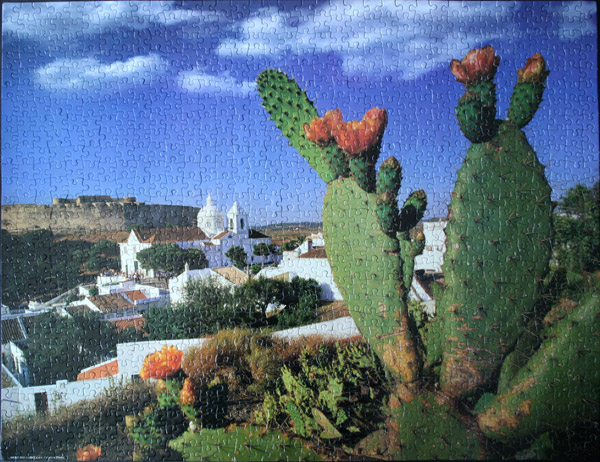
Size: 1000 pieces
Dimensions: 51.12cm x 66.52cm
Producer: Big Ben, MB Puzzles
Notes: Vila Real de Santo Antonio was erected at great speed, in only two years time (construction took place between 1774 and 1776). The Marquis of Pombal was responsible for its planning. He designed the town in a Pombaline orthogonal grid. In a pioneering technique, entire buildings were prefabricated in pieces outside the city, and then transported to their final destination to be assembled. This procedure permitted a fast and methodical construction of the town.
Vila Real de Santo Antonio started to thrive by the end of the 19th century thanks to the growth of the fish industry and concentration of fish-processing plants in the city. Tuna and sardine were particularly important to the city’s economy. In 1886, it became the first city in the Algarve to have gas lighting installed. The fish industry came to a decline in the 1960s and tourism quickly took over as the principal income generator.
Several artists were born and/or worked in Vila Real de Santo Antonio, providing a rich heritage in literature and visual arts. The native poet Antonio Aleixo was particularly prominent. [Wiki]
Puzzle: New Palace Gardens, Warwickshire, England
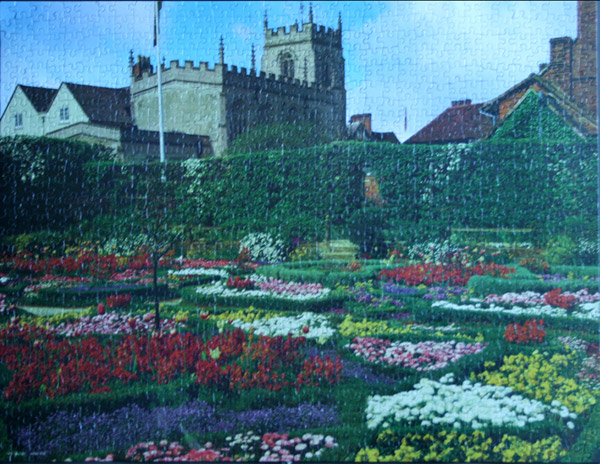
Size: 1000 pieces
Dimensions: 51.12cm x 66.52cm
Producer: Big Ben, MB Puzzles
Notes: Warwickshire is perhaps best known for being the birthplace of William Shakespeare from Stratford-upon-Avon. Even today, road signs at the county boundary describe Warwickshire as “Shakespeare’s County”. The county has also produced other literary figures such as George Eliot (from Nuneaton), Rupert Brooke (from Rugby), and Michael Drayton from Hartshill.
Much of western Warwickshire, including that area now forming part of Birmingham and the West Midlands, was covered by the ancient Forest of Arden (most of which was cut down to provide fuel for industrialisation). Thus the names of a number of places in the northwestern part of Warwickshire end with the phrase “-in-Arden”, such as Henley-in-Arden, Hampton-in-Arden and Tanworth-in-Arden. The remaining area, not part of the forest, was called the Felden – from fielden. [Wiki]
Puzzle: Angkor Wat, Cambodia

Size: 500 pieces
Dimensions: 38 cm x 52 cm
Producer: TOMAX, #61101
Notes: Angkor Wat is a temple complex at Angkor, Cambodia, built for the king Suryavarman II in the early 12th century as his state temple and capital city. As the best-preserved temple at the site, it is the only one to have remained a significant religious centre since its foundation – first Hindu, dedicated to the god Vishnu, then Buddhist. It is the world’s largest religious building. The temple is at the top of the high classical style of Khmer architecture. It has become a symbol of Cambodia, appearing on its national flag, and it is the country’s prime attraction for visitors. Angkor Wat combines two basic plans of Khmer temple architecture: the temple mountain and the later galleried temple, based on early South Indian Hindu architecture, with key features such as the Jagati. It is designed to represent Mount Meru, home of the devas in Hindu mythology: within a moat and an outer wall 3.6 kilometres (2.2 mi) long are three rectangular galleries, each raised above the next. At the centre of the temple stands a quincunx of towers. Unlike most Angkorian temples, Angkor Wat is oriented to the west; scholars are divided as to the significance of this. The temple is admired for the grandeur and harmony of the architecture, its extensive bas-reliefs and for the numerous devatas (guardian spirits) adorning its walls. [Wiki]
Puzzle: Taj Mahal Dreams by Walter Pepperle
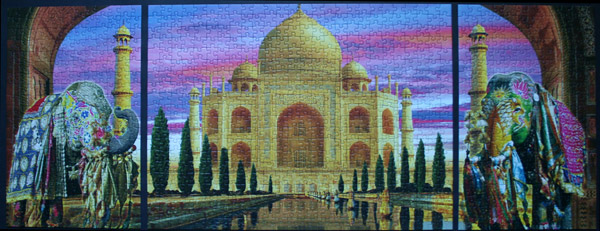
Size: 1000 pieces, triptychon
Dimensions: 98cm x 37.5cm
Producer: Ravensburger, no. 19 990 7
Artist: Walter Pepperle
Box: Puzzles and Beyond
Notes: The Taj Mahal (from Persian/Urdu: “crown of buildings”) is a mausoleum located in Agra, India. It was built by Mughal emperor Shah Jahan in memory of his third wife, Mumtaz Mahal. It is widely considered as one of the most beautiful buildings in the world and stands as a symbol of eternal love.
Taj Mahal is the finest example of Mughal architecture, a style that combines elements from Persian, Islamic and Indian architectural styles.
Should guilty seek asylum here,
Like one pardoned, he becomes free from sin.
Should a sinner make his way to this mansion,
All his past sins are to be washed away.
The sight of this mansion creates sorrowing sighs;
And the sun and the moon shed tears from their eyes.
In this world this edifice has been made;
To display thereby the creator’s glory.
[Shah Jahan]
[Wiki]
Puzzle: Bay Bridge, San Francisco, U.S.A.
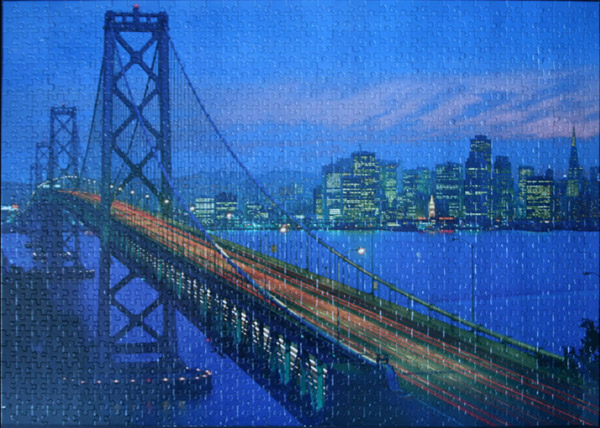
Size: 1000 pieces
Notes: The San Francisco – Oakland Bay Bridge (known locally as the Bay Bridge) is a pair of bridges spanning San Francisco Bay of California, in the United States. Forming part of Interstate 80 and of the direct road route between San Francisco and Oakland, it carries approximately 270,000 vehicles per day on its two decks. It has one of the longest spans in the world.
The toll bridge was conceived as early as the gold rush days, but construction did not begin until 1933. Designed by Charles H. Purcell, and built by American Bridge Company, it opened for traffic on November 12, 1936, six months before the Golden Gate Bridge. It originally carried automobile traffic on its upper deck, and trucks and trains on the lower, but after the closure of the Key System, the lower deck was converted to road traffic as well. [Wiki]
I do not have a record of the producer of the puzzle as I do not have the box anymore. A clarification is welcome – if you have any clue as to the details regarding this puzzle, I would much appreciate that information.
Puzzle: Royal Courts, London
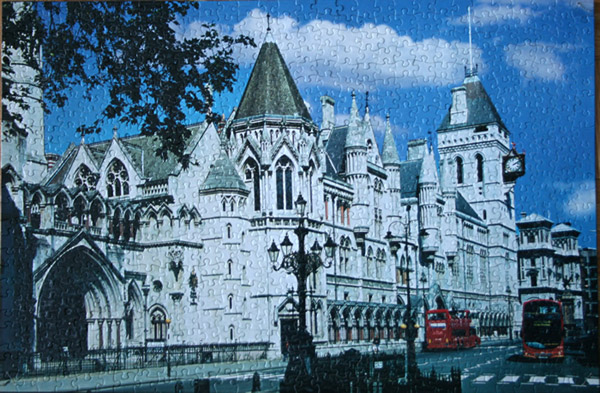
Size: 750 pieces
Dimensions: 59.7 cm x 39.4 cm
Producer: Sure-Lox, Impressions
Notes: The Royal Courts of Justice, commonly called the Law Courts, is the building in London which houses the Court of Appeal of England and Wales and the High Court of Justice of England and Wales. Courts within the building are open to the public although there may be some restrictions depending upon the nature of the cases being heard. The building is a large grey stone edifice in the Victorian Gothic style and was designed by George Edmund Street, a solicitor turned architect. It was built in the 1870s. The Royal Courts of Justice were opened by Queen Victoria in December 1882.
Entering through the main gates in the Strand one passes under two elaborately carved porches fitted with iron gates. The carving over the outer porch consists of heads of the most eminent Judges and Lawyers. Over the highest point of the upper arch is a figure of Jesus; to the left and right at a lower level are figures of Solomon and Alfred the Great; that of Moses is at the northern front of the building. Also at the northern front, over the Judges entrance are a stone cat and dog representing fighting litigants in court. [Wiki]





